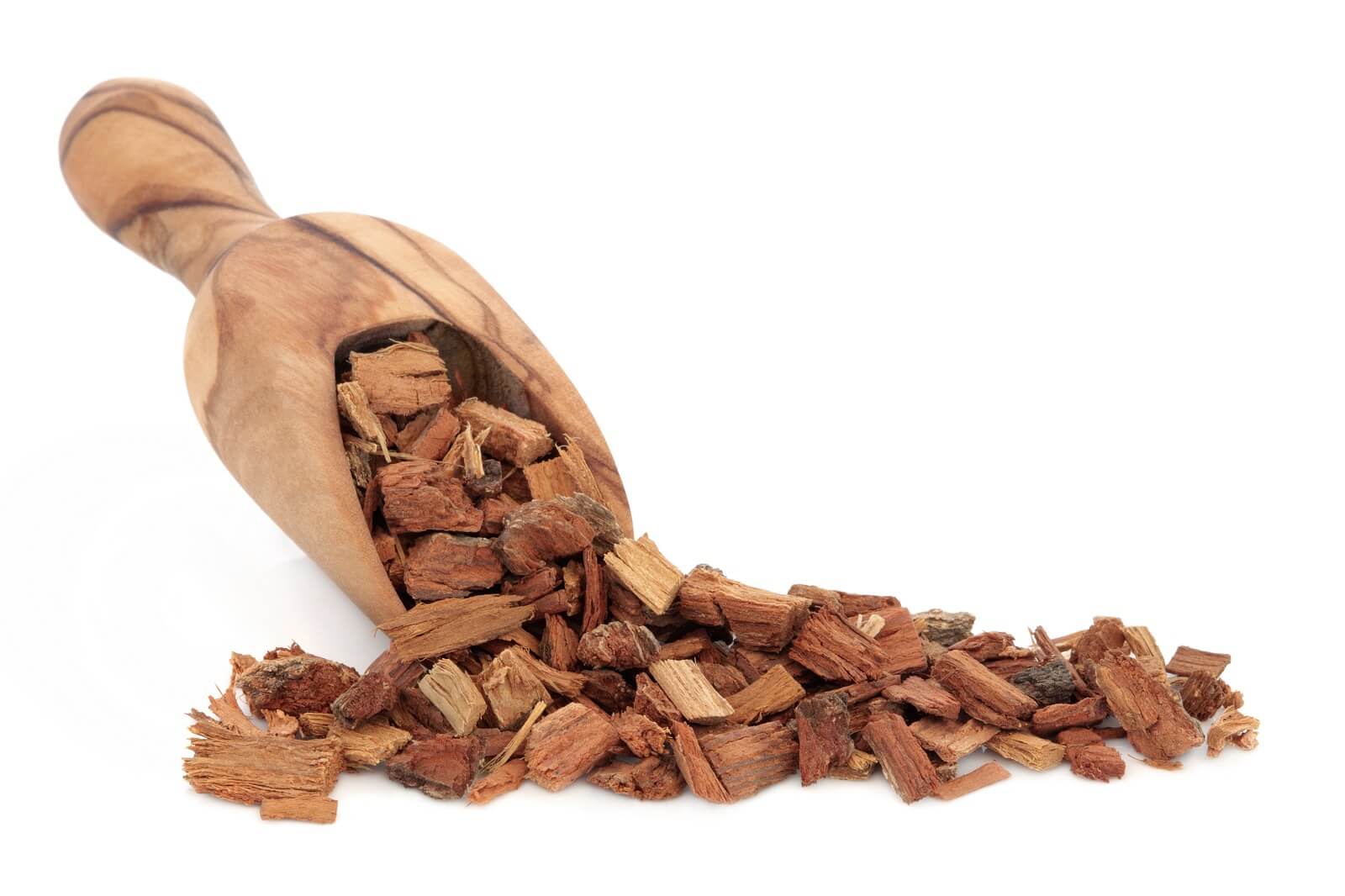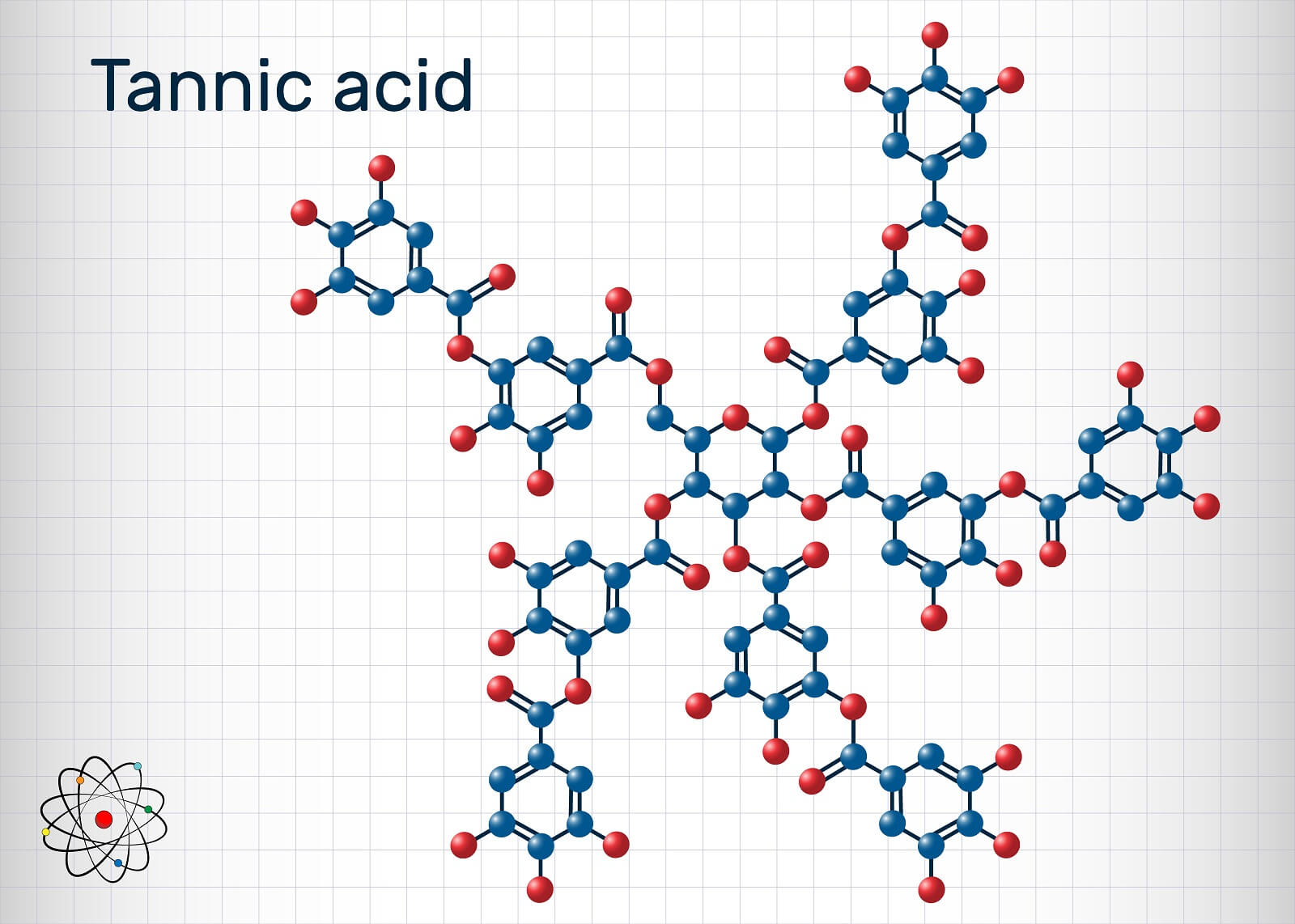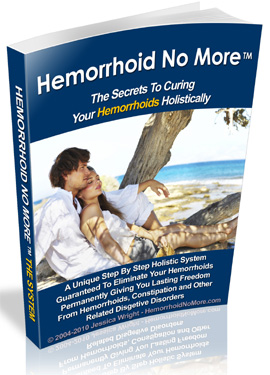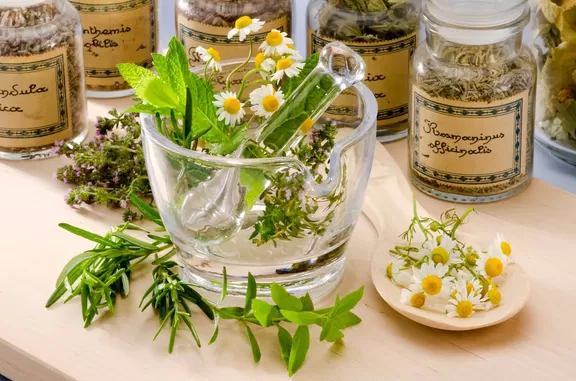
White oak (Quercus alba) bark is a good herbal remedy for hemorrhoids. This herb can assist with hemorrhoids both externally and internally. It is such an efficacious herb for this indication that Herbsey’s herbalist expert, Ms. Tricia Perez (MS, CPT), uses it in both her recommended internal and external hemorrhoid treatments (see the recipes here).
Generally, white oak bark has three primary ways it helps with hemorrhoids:
- Natural astringent
- Wound healing
- Assists vein function
The reason white oak probably works so well externally is due to the fact it is rich in something known as tannins.
Tannins are often referred to as tannic acid and are water-soluble polyphenols that are present in many plant foods.(source 1) They probably get their name from the fact that they can be used in the hide tanning process.
Because tannins interact with the skin, they can help create a protective “coat” on a wound or inflamed hemorrhoids. This will help stop the bleeding, assist in healing, relieve pain; and, tannins also will help to reduce inflammation.
The next reason white oak is a good choice for treating hemorrhoids is due to its ability to help the veins to function. As we will discuss, hemorrhoids can be thought of as varicose veins of the anus; essentially a vein dysfunction.
Because white oak can help with varicosities and venous laxity, it may be able to impart some internal support to swollen hemorrhoids.
Naturally Treat Hemorrhoids in 48 Hours
Jessica Wright’s unique 5-step, all-natural approach to hemorrhoid treatment delivers permanent relief. Heal hemorrhoids in 48 hours, and eliminate the root cause in 30 to 60 days.
Benefit from Jessica’s 12 years of research; her book is backed by a 60 day, 100% money back guarantee.

Validity of using White Oak for Hemorrhoids
A 2020 study in Evidence-Based Complementary and Alternative Medicine(source 2) looked at the medicinal uses of oak. According to the paper traditional medicine has used oak for hemorrhoids. Some of the medicinal uses for this herb include:
- Astringent
- Venotonic (a class of therapies that relieve vein disorders, particularly venous insufficiency)
- Hemostatic (stops bleeding)
According to the 2010 book Botanical Medicine for Women’s Health(source 3) white oak bark is rich in tannins, much like witch hazel and black tea. It is commonly utilized as a topical remedy for hemorrhoids.
Concerning precautions, this book cautions that white oak is not intended for internal use during pregnancy.
Externally, white oak can be used as a strong wash or by diluting the extract and applying it with a cotton ball to the hemorrhoidal area. Herbal suppositories can also be inserted nightly to reduce inflammation and swelling in the anal area.
Concerning using a suppository, this book states:
An herbal suppository can be inserted nightly to shrink hemorrhoids and relieve itching, burning, and irritation. Use 4 oz of cocoa butter and 2 tbs each of marshmallow root, white oak bark, and goldenseal powders, as well as 2 tbs of calendula oil which is [a wound healer].
Botanical Medicine for Women’s Health
A 2022 study in the Journal of Drug Delivery and Therapeutics(source 4) also shows that white oak is a suitable treatment for hemorrhoids. Some of this herb’s medicinal properties and conditions it can be used for are listed as follows:
- Astringent
- Bleeding Hemorrhoids
- Congestion
- Mucous Membrane Irritation
- Passive Hemorrhages
- Styptic (stops bleeding when applied to wounds)
- Varicosities
- Venous Laxity
Samuel Bart’s Digestive Health Solution
Samuel Bart has always been passionate about plants and their ability to keep us healthy. He has put together some of the best natural ways that could help anyone support a healthy digestive system.
Samuel perfected an easy, yet powerful formula, which consists of amazing ingredients. Bart’s supplement is backed by a ironclad 60-day, money back guarantee.

How White Oak’s Tannins Help with Hemorrhoids

A 2001 study in the Journal of Agricultural and Food Chemistry(source 5) found the total amount of tannins in white oak. The tannins are divided into two basic chemicals: gallic acid and ellagic acid. The amounts are as follows:
- Gallic acid/g of wood: approximately 30.7 mg
- Ellagic acid/g of wood: approximately 4.06 mg
To give an idea of a tanning rich herb, one is witch hazel. Witch hazel extract has around 5% tannins (weight / weight) in it. The most abundant tannin in the herb is hamamelitannin.(source 6) This is a key reason why witch hazel is used as a hemorrhoid therapy.
Now keep in mind that an extract of an herb is going to be more potent in phytochemicals (plant chemicals) than just say the unextracted bark of white oak. But, it is reasonable to assume a white oak extract would also have a much higher concentration of tannins in it.
Suffice it to say, just like witch hazel, white oak also stands to be a good remedy for hemorrhoids due to the tannin content.
The 2010 book Botanical Medicine for Women’s Health(source 7) discussed the astringent action of tannins in detail. According to this book, the basic use of a tannin is to tone or tighten tissue. They can be used to stop both external and internal bleeding. All tannins have phenolic characteristics and are soluble in water.
Tannins interact with skin tissue because they cause chemical reactions when exposed to proteins. Tannins denature protein molecules and can cause them to precipitate (form solid particles within a solution).
Tannins also precipitate gelatin, starch, alkaloids, and salts of heavy metals. One caution when working with tannins as an herbalist is that tannin rich herbs can create precipitates with other herbs that are high in alkaloids.
Yet, the important thing to take from this book’s overview on tannins, is that tannins produce a type of temporary "leather coat" on the surface of tissue via their astringent action. Consequently, the therapeutic advantages tannins provide are:
- They create a barrier against infection; which is ideal for bleeding hemorrhoids.
- Tannins reduce surface inflammation.
- Tannins can reduce the irritation of surface tissue by a type of numbing action.
According to a 2015 study in the African Journal of Pharmacy and Pharmacology(source 15) states that purified tannic acid can be an important treatment for wound healing. It was also shown to promote the stabilization of collagen against degradation; this led to improvement in wound healing in rats.
This study also goes on to explain tannic acid and its wound healing potential:
The tannic acid is a polyphenol with several properties that give it different applications, including leather and pharmaceutical industry. It belongs to the group of water soluble metabolites, and has the ability to complex macromolecules and metal ions, which gives it antioxidant, antimicrobial and healing activity. Therefore, such properties can be used to develop technologies related to wound healing systems.
African Journal of Pharmacy and Pharmacology [9.26 (2015): 662-674]
Further Benefits of Tannins
A 2021 study in Foods(source 8) went into great detail about tannins.
The study states that traditionally the most popular use for tannins was either taking them orally or using them topically.
If tannins are taken orally, they have two primary ways in which they exert their medicinal effects: via becoming absorbable or nonabsorbable chemicals in the gut.
When tannins form nonabsorbable chemical complexes this can result in a host of potential localized benefits in the gastrointestinal tract; such as:
- Antioxidant
- Antimicrobial
- Antimutagenic
- Antinutrient
- Antiviral
- Radical Scavenging
Absorbable tannins, on the other hand, are simpler metabolites that often have low molecular weight. These types of tannins are able to be absorbed into the blood and thereby reach other parts of the body; eventually causing systemic effects.
This study also says that oak species have scientific evidence verifying their medicinal use. Traditional uses of oak include the treatment of mild inflammations. The antioxidant properties of oak might lower oxidative stress that are caused by cycles of inflammation.
Some of the uses the study lists for oak species are:
- Skin injuries
- Respiratory affections (cold and flu)
- Diabetes
Therefore tannins in white oak make a great addition to an external and internal remedy to help fight inflammation. External application is also a good way to help disinfect and encourage wounds to heal. Internal use might noticeably reduce inflammation.
Dr. John Herzog (MD)
Dr. John Herzog, a "survival surgeon" from Maine explains what home remedies work best in a crisis situation.
This may be important in the event you require first-aid or are in an emergency situation without easy access to a hospital. Dr. John Herzog has assembled a large collection of home remedies for such scenarios.

White Oak & Varicose Veins - The Connection

First, it is important to understand that hemorrhoids can be thought of as varicose veins of the rectum near the anal canal.(source 9) The prominent herbal medicine expert, the late Dr. James Duke, also states that hemorrhoids are varicose veins of the anus.(source 10)
The Merck Manual(source 11) defines hemorrhoids as Varicosities of the veins of the hemorrhoidal plexus, often complicated by inflammation, thrombosis, and bleeding.
Oak is relevant to the conversation of varicose veins and hemorrhoids as it has been traditionally used as a treatment for these two diseases.(source 12)
A 2022 study in the Journal of Drug Delivery and Therapeutics(source 13) states that there are several uses, some particularly useful for vein health and hemorrhoids, when it comes to white oak; these include:
- Astringent
- Bleeding Hemorrhoids
- Congestion
- Hemorrhages
- Mucous Membrane Irritation
- Styptic (stops bleeding)
- Varicosities
- Venous Laxity
Therefore, the venotonic ability of white oak may allow it to help veins to function better, thus reducing the severity of hemorrhoids.
Claire Goodall’s Amazing Guide
Clair Goodall is a bee-obsessed, natural medicine convert from Minnesota (USA). And, she does keep bees!
Clair has created 350+ page book documenting how to replace the toxic products and medications in your home with healthier, all-natural alternatives.

Heal Hemorrhoids Naturally in 48 Hours

If you have tried "everything" to treat hemorrhoids, including surgery, but it didn’t work—your’re not alone. Jessica Wright experienced this same hardship due to hemorrhoids. But, with extensive research and understanding of natural medicine, she developed a solution to permanently end her hemorrhoids.
Jessica Wright wrote an entire book detailing exactly how to replicate her success. Also, it appears "Jessica Wright" is probably a pen name for a woman—and author—named Linda Allen. Linda suffered from recurrent yeast infections as well, maybe at the same time as she had hemorrhoids. She turned to natural medicine for answers when medical doctors and their solutions could not help.
Jessica’s story is one of severe and chronic hemorrhoids. It involves routine doctor’s visits, prescription medications / creams, significant suffering from hemorrhoids, and even a two hour hemorrhoids surgery (stapled hemorrhoidopexy). Yet, 12 years of these treatments didn’t resolve Jessica’s hemorrhoids.
Despite these setbacks, Jessica didn’t give up; instead, she turned to natural medicine and diligent research. Skipping to the end of Jessica’s story, she would develop a natural method to treat hemorrhoids that worked brilliantly.
After Jessica put together her treatment protocol and used it, she found her hemorrhoids completely disappeared. And, they stayed gone. Something her doctor was not able to do. Yet, all it took was the right natural therapeutic approach.
Jessica also gave her treatment approach to others; and, they experienced the same exceptional results. Typically, Jessica’s system provides dramatic relief of hemorrhoids in just 48 hours. And, the root cause of hemorrhoids is fixed within 30 to 60 days.
A company selling hemorrhoid symptom products does not want their customer base diminished. Consequently, unpatentable natural medicine does not get much attention or publicity.
So, how can you know if Jessica Wright’s claims are legitimate and not a scam? That is a great question. Here are 3 important reasons why Jessica’s book is legitimate:
- It is published by a large U.S. based company (Located in Idaho) known as ClickBank. ClickBank handles all the sales and refunds of many products like Jessica’s. They do business in many countries; and, have been in business for many years.
- ClickBank provides a 60 day, 100% money back guarantee on all their products, Jessica’s book included.
- If you are not satisfied with Jessica’s book you can simply contact ClickBank (they make it very easy) for a full refund.
Jessica’s story is more in-depth than this concise overview. And, there are additional bonuses Jessica provides with her book. If you’d like to find out more about Jessica’s personal story or her hemorrhoid treatment; you can learn more at Jessica Wright’s website.
About the Author
Nick Gross is a natural medicine enthusiast who has been researching and writing about natural medicine since 2008. Nick is primarily a web developer, but also researches and authors written and video content about natural health. Nick has a bachelor’s degree in Management Information Systems from the University of Northern Iowa.
More on Nick GrossImportant Disclosures & Disclaimers
It is important to use the information you find on Herbsey.com in the right way. Also for legal reasons, these disclaimers and disclosures are necessary. For further information about each, feel free to click the link provided to the page on this website that provides more information.
Medical Disclaimer
The information on this website is not a prescription for anyone. This information is for informational or educational purposes only, and is not a substitute for professional medical advice or consultations with healthcare professionals.
Advertisement Disclosure
Some of the links provided on this article and website are affiliate links. If you purchase a product after clicking on these links, Herbsey.com will earn a commission. Herbsey.com promotes various products through advertisement and text links. For more information: Our Advertisements.









